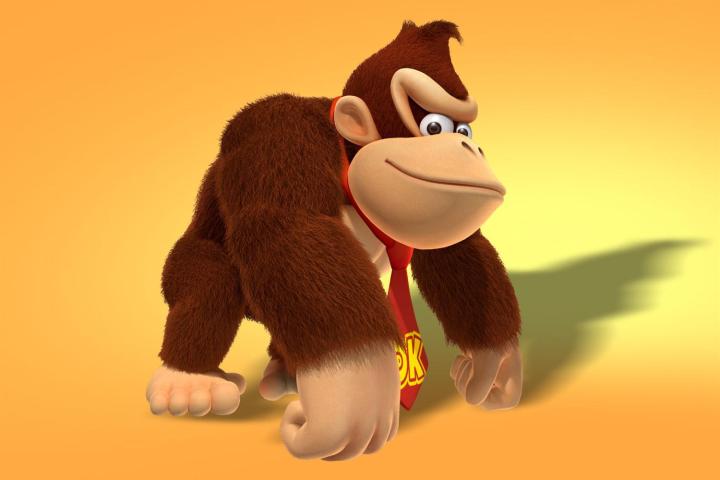
The Adversary
DK began his life in 1981 when Nintendo was attempting to create a Popeye game. The licensing deal fell through, and so the developers saw it as an opportunity to create original characters that could then be used in subsequent games. Designer Shigeru Miyamoto based the Mario/Pauline/Donkey Kong triangle on Popeye, Olive Oyl, and Bluto. He mistakenly thought that “donkey” meant “stupid” in English, intending the name to convey “stupid ape” to Americans. Nintendo of America representatives laughed at him when he presented the idea, but the name stuck.
Donkey Kong was the first platform game to introduce jumping, setting the genre template that the game’s hero, Jumpman, would go on to perfect as “Super” Mario in 1985. The game is notorious among classic arcade aficionados for its punishing difficulty, which the 2007 documentary The King of Kong: A Fistful of Quarters elucidated. Guinness World Records also recognized it as the first use of visual storytelling in a video game, utilizing the first cutscenes to create a coherent narrative with a beginning and end.
Universal Studios sued Nintendo in 1982, alleging that the character infringed upon King Kong. The suit was shot down, however, on the grounds that no one was likely to confuse the two, and that Universal itself had actually sued RKO Pictures in 1975 to prove that the plot of King Kong was in the public domain, opening up the way for their own 1976 remake. Nintendo won subsequent counterclaims and Universal was roundly chastised for recklessly asserting trademarks it did not in fact own.
The Hero
Not content to sit on the sidelines, DK took center stage as the hero of Donkey Kong Country, developed by British studio Rare for the SNES in 1994. Widely praised by critics, the game stands as the console’s second best selling title after Super Mario World. The use of pre-rendered 3D graphics was revolutionary at the time, utilizing new compression techniques that managed to squeeze more detailed visuals out of the SNES than had previously been possible.

The game was also noted for the vast array of secrets lurking in every level, which were avidly shared on playgrounds around the world. The game went on to have numerous sequels and ports, the most recent of which came out for Wii U earlier this year.
Although his iconic red necktie was introduced earlier that year in the Game Boy adaptation of Donkey Kong, Country gave him the prominent brow, cowlick, and proportions that have remained standard to this day. It was also the first time we learned about DK’s backstory, introducing extended family like Diddy and Kranky Kong.
The Racer
Donkey Kong himself didn’t take part in the first Super Mario Kart for SNES, but his son did. Donkey Kong Jr. was the star of an eponymous arcade game from 1982, in which he rescued his father from cruel imprisonment by Mario. Junior faded into obscurity with the rise of Diddy Kong, and Super Mario Kart would prove to be his final appearance.

DK himself stepped onto the tracks for the 1996 sequel, Mario Kart 64, and has been a core member of the racing crew ever since. His large size and high top speed make him tough to topple, but hard to handle, and he rivals Bowser for having the most courses named after him.
The Fighter
Mario Kart set the template for Nintendo taking its diverse stable of original characters and putting them in new contexts, but 1999’s Super Smash Bros. for the N64 took that to a whole new level. DK was a core fighter from the start, filling the role of the hard-hitting heavy with great reach and powerful punches but no projectiles to speak of.

He has returned in every subsequent iteration of the game, including the hotly-anticipated Wii U sequel that will arrive later this year.
The Musician
The forgotten stepchild of Nintendo consoles, the GameCube featured some of Nintedo’s odder experiments, including the 2003 rhythm game Donkey Konga. Dance Dance Revolution was going strong in the arcades, but Guitar Hero had not yet carved out a solid foothold for rhythm games at home. Donkey Konga required a bongo peripheral controller that you would play in time to songs like Louie Louie and Rock Lobster. The game was moderately well-reviewed at the time, and took home Best Innovation from GDC, but the 2004 sequel fizzled and the bongos were left to collect dust, like so many other plastic instruments that followed them.
DK’s other notable (and maligned) foray into music is the DK Rap, which first appeared in the intro to Donkey Kong 64 and has since graced the soundtracks of Donkey Konga and Super Smash Bros. Melee/Brawl.
The Truck
In 2007 Feld Motorsports debuted a monster truck designed to look like Donkey Kong. The custom concept body was molded to look like DK’s face, with eyes on the windshield, hair tuft up top and his iconic red necktie hanging in front.

Driver Frank Krmel piloted Donkey Kong to the Monster Jam World Finals 9 and 10, placing in the middle of the pack at both events.DK’s cartoonish appearance has made the truck a favorite among children who follow the Monster Jam tour.



